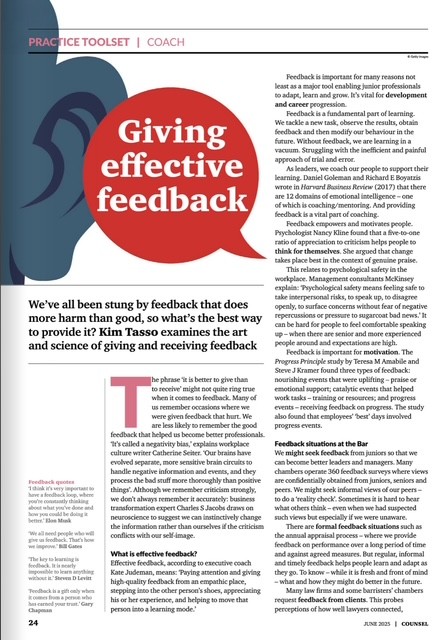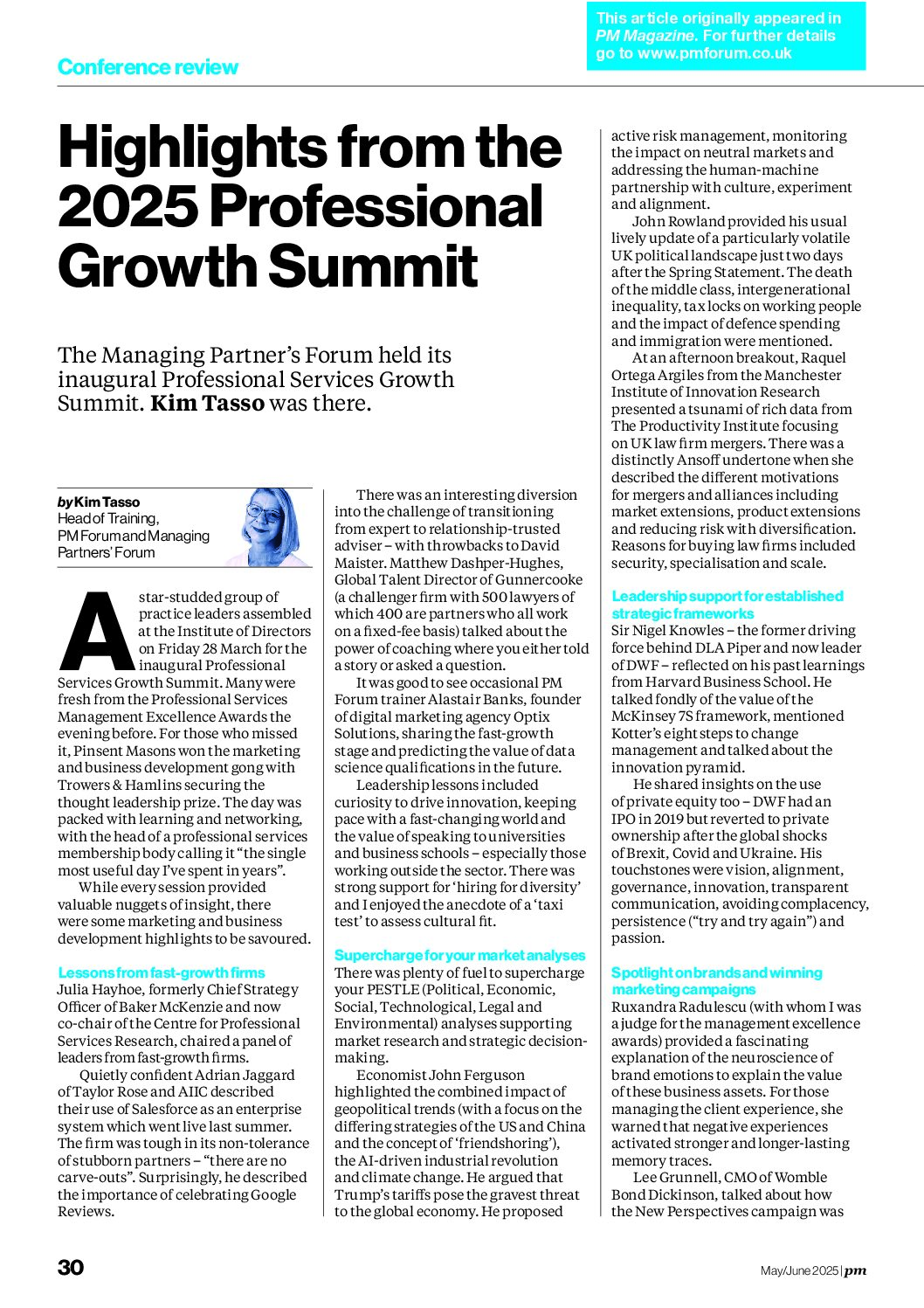
At last week’s “Managing and marketing a profitable surveyors’ practice” workshop in Glasgow, where the focus was on how to achieve profitable growth, the delegates identified six insights into managing a surveyors’ practice
1. Produce a (short) strategic business plan
Some firms had a business plan that needed to be updated. Some firms felt that they were too small to need a plan. However, we reflected that the value was often in the journey (analysis and thinking) rather than the destination (the plan). All agreed that there was value in taking some “heads up” time to think about the future goals and shape of the practice. Taking a helicopter view – rising up above the detail to see the big picture – could guard against strategic drift (see http://kimtasso.com/strategic-drift-a-risk-for-partnerships/) .
Smaller firms talked about the difficulty of finding time away from the fire-fighting and fee-earning to survive in the short term. Larger firms talked about the challenge of achieving consensus across multiple offices and departments. Everyone recognised that too much time was spent in board and management meetings sweating the small stuff because there was a lack of (or perhaps an avoidance of) over-riding goals and priorities on which the majority of partners agreed to focus. Again, the helicopter view was seen as an antidote to silo thinking.
Some found value in splitting the task between an operational business plan for running the practice in the short term and a separate strategic business plan for how to change markets, services, people and technologies to create a different practice in the medium and long term. That’s planning for the firm of today separated from planning for the firm of tomorrow. Others found it helpful when we considered the core challenge that the practice needs to overcome in order to grow and focusing the business plan and strategy on addressing that core issue.
Most thought that the various tools to identify (and discuss with staff) goals were helpful. For example:
- Mission (Why are we in business? The fundamental reason for the business’ existence. Like a guiding star – work towards but never fully attained )
- Vision (Where do we want to go? A bold, compelling audacious goal (a clear finish line and a deadline) and
- Values (How will we do this? Guiding business principles or philosophy). The tool for communicating strategic guidelines was also appreciated.
And everyone recognised the need to focus on just one or two major strategies rather than spreading themselves too thinly on an extensive project list. Less is more.
2. Concentrate on recruiting more of the right people
Most delegates identified a lack of the right calibre people as a major constraint to growing their practice. Whether this was a lack of people for succession who could step into a “second in command” role and relieve the practice leaders to lead or suitably qualified people to complete client work at the appropriate level or those with different skills to help the firm move into new markets and services.
Several firms are experimenting with different routes into the profession including apprenticeships and graduate sponsorships. Others are using on-line methods and other rewards to incentive staff and external referrers. There was a reluctant acceptance of the need to consider flexible employment arrangements to accommodate the needs of part-time skilled workers and Millennials.
But there were also some discussion about helping existing staff to step up by various learning and development programmes including shadow boards, delegated management projects and training/coaching programmes. I talked about one firm that had improved recruitment while simultaneously reducing recruitment agency costs by using advertising and social media campaigns on LinkedIn.
3. Manage your change management programmes
The usual exasperation in achieving change was expressed. We talked about the psychological advice on achieving change with people (see, for example, http://kimtasso.com/change-management-book-review-switch-how-to-change-things-when-change-is-hard-by-chip-and-dan-heath/).
We also talked about many of the concepts covered in previous sessions on change management (see http://kimtasso.com/change-management-in-a-surveyors-practice-bridging-the-gap-between-the-old-and-the-new/) and we also considered some psychological theories of motivation http://kimtasso.com/top-tips-for-motivating-people/.
Aligned to this was a general discussion about human resources management and several smaller firms indicated that they used out-sourced HR expertise which they realised they needed to use in a more strategic way. http://kimtasso.com/people-management-in-a-property-partnership/
4. Focus on your target markets and be bold on pricing
Once again, the market mapping (or spider diagrams as one of my clients call them) proved useful in helping delegates identify their target markets and realise that their current targeting and messaging was too broad, generic and diffuse.
And whilst information about the property market itself was generally regarded as good, the commercial and business needs of various target markets – whether commercial or consumer – were generally felt to be lacking.
The disruption caused by commoditisation and new (often low fixed price) entrants supported the view that smaller firms needed to develop niche markets and focus on segments where they could add real value – whether through a trusted adviser relationship or by innovating new products and services.
Linked to the commoditisation issue, several firms were experiencing severe fee pressure as the market “raced to the bottom”. As well as more targeted focus on segments of the markets, we talked about value perception. Several firms agreed that they needed to understand the relationship between price and client perception of value at various stages in the property service chain.
We also talked about the need for clarity in what the service comprises and the value and benefits available. And ideas around unbundling, packaging and developing a range of services at different price points so that clients had more information on what was available and a choice of options.
The dinosaurs came out again (see http://kimtasso.com/be-more-t-rex-client-management-with-dinosaurs/). And everyone committed to doing some further analysis on the source and profitability of different categories of clients. Several delegates committed to cut off the tail of their client base.
5. Review your networking and contact management programmes
With a lack of a structured approach to selling (whether in complex sales in the commercial and referrer markets or more straightforward selling for consumer/residential markets) there were concerns that too much resource was being invested in contacts that were not converting into profitable clients.
The starting point for several delegates was obtaining better information about the current source and value of leads – whether through existing clients, referrers or digital channels. Some delegates recognised the need for better technology, systems, processes and behaviours on capturing this information.
We spent some time thinking about the challenge of moving contacts from continuation to progression by considering the decision making unit (DMU) and decision making processes. We also considered grading and prioritising contacts and using social media methods to manage some segments of the contact base. http://kimtasso.com/getting-your-head-around-basic-selling-skills/
Several delegates decided that they needed to help younger members of their team develop appropriate professional selling skills and confidence through training, coaching and shadowing programmes. Others decided that they needed to interrogate the partners and data about their sales pipeline (sales funnel) and their sales cycles so that best practice and processes could be captured and shared.
Concepts such as “less is more” and “do less but go big” were considered
6. Embrace digital and social marketing
While some had dipped their toe in the water into digital marketing, others have yet to be convinced. We explored the difference between outbound “push” and inbound “pull” approaches to marketing, the merits and weaknesses of each approach and the importance of search engine optimisation (SEO) and keywords.
I think we converted a few folk on the value of LinkedIn and Twitter for obtaining market intelligence, sharing expertise (particularly to support cross-selling of colleagues’ services), keeping up with the activities of clients and referrers and keeping in touch with all contacts. Case studies of where LinkedIn had been used effectively for recruitment were also considered.
We looked at some of the basics to get started and particularly the need to measure impact whether this was through analytics (both Google Analytics for web sites and WordPress for blogs), Everyone was interested in both the Hubspot Marketing Grader to assess the effectiveness of their web sites and in social media measurement tools such as Klout and PeerIndex. They heeded the warnings about vanity analytics and recognised the need to develop integrated digital and person-to-person business development campaigns.
The other surprising insight into managing a surveyors’ practice we obtained was that many of the issues relating to planning, partnership collaboration, human resource management and internal communication were surprisingly similar for both large and small partnerships.
Details of future dates and locations for this session are here https://www.mblseminars.com/Outline?progid=5865&AddSeminarToBasket=1027490
The course is based on the book http://kimtasso.com/publications/growing-your-property-partnership/









